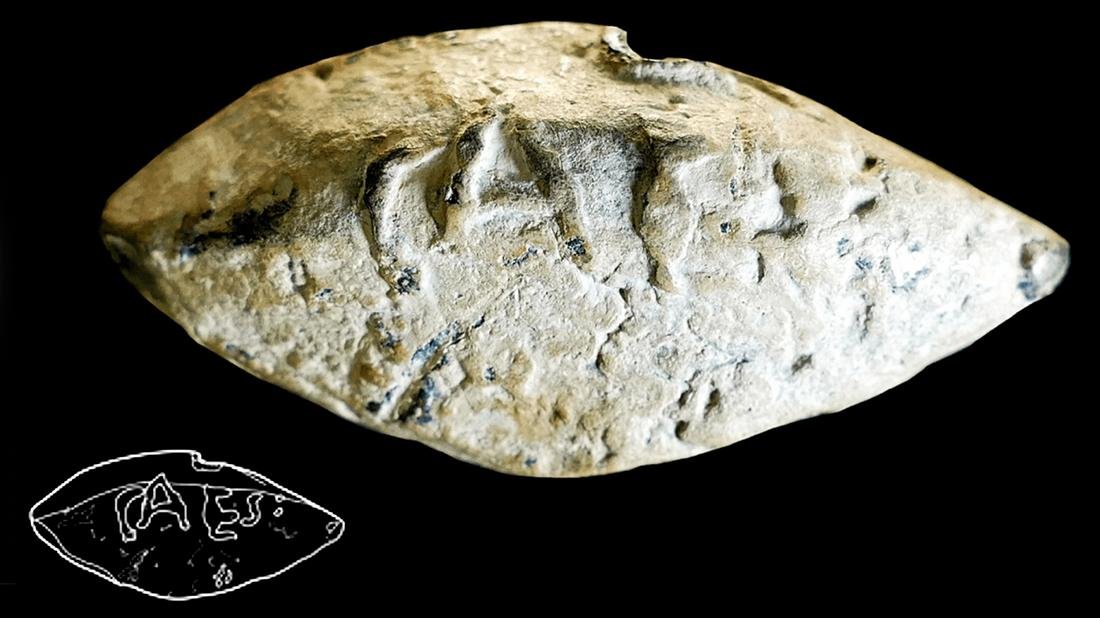A lead sling bullet inscribed with the name of Julius Caesar and the Ibero-Roman city Ipsca has been unearthed in the countryside of Montilla, Andalusia, Spain.
 Credit: STILEarte/Javier Moralejo Ordax et al., Zephyrus (2023)
Credit: STILEarte/Javier Moralejo Ordax et al., Zephyrus (2023)
This finding, detailed in a study published in the scientific journal Zephyrus, marks the first incontrovertible inscription of Caesar’s name on this type of projectile in the Iberian Peninsula. The lead projectile, shaped like an acorn with pointed ends, measures 4.5 centimeters long, 2 centimeters wide, and 1.7 centimeters high, weighing 71.1 grams.
The projectile’s inscription features the abbreviation “CAES” for Gaius Julius Caesar and the toponym “IPSCA,” representing the Roman city that once stood on the border of the present-day territory of Baena.
This discovery, the first of its kind in Roman Hispania, has sparked extensive research led by Javier Moralejo and Jesúss Robles from the Autonomous University of Madrid, along with Antonio Moreno from the Archaeological Museum of Cabra and José Antonio Moreno from the Museo Histórico of Baena.
The historical significance of this find is underscored by the fact that the lead sling bullet is not only inscribed with Caesar’s name but also bears the toponym of Ipsca, affirming the city’s alliance with Caesar’s faction during the Roman Civil War. Ipsca, an Iberian oppidum and later a Roman municipality, stood about 12 miles from Montilla.
The study suggests that the projectile may date back to the Second Hispanian campaign of Caesar’s Civil War, potentially linked to the Battle of Munda, a topic of historical debate. Ipsca’s clear support for Caesar is evident in the inscription, affirming a strong alignment with the general’s cause.
The projectile’s discovery aligns with historical accounts of the Battle of Munda, the final clash of the civil war in 45 BCE, where Julius Caesar faced the sons of Pompey, Gnaeus, and Sєxtus Pompeius. The exact location of the battle has long been a subject of debate, with the Montilla area emerging as a leading candidate. The lead sling bullet’s inscription not only supports this candidacy but also provides crucial details not found in ancient sources like the Bellum Hispaniense.
Lead sling bullets with inscriptions, known as “glandes inscriptae,” have a historical lineage dating back to 5th century BCE. Greece and continued through the early Roman imperial era. These projectiles often featured inscriptions such as the maker’s name, the military commander, the legion, or the deployment location.
The discovery challenges previous ᴀssumptions about these lead sling bullets, as they were typically ᴀssociated with specific wars, such as the Sertorian War or Caesar’s conflict with Pompey. The Montilla projectile, found during agricultural work in 2019, lacks inscriptions found in similar projectiles at the Roman city of Ulia Fidentia, located eight miles north of the discovery site.
The lead bullet’s inscription not only provides new information about historical alliances but also raises questions about the term “sponsorship” in ancient contexts.





